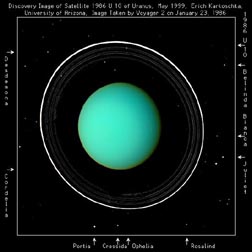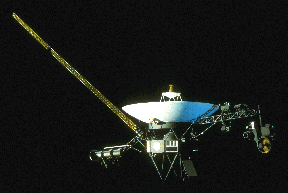Click on image for full size
Courtesy of NASA
Related links:
Yet Another Moon for Uranus...
News story originally written on August 16, 1999
Another moon has been found orbiting the planet Uranus. This increases the total number to 18, leaving Uranus tied with Saturn as the planet with the most moons. Discovered by a University of Arizona scientist, the satellite is named Satellite 1986 U 10.
This finding is particularly interesting because 13 year old photographs were used to find the moon. In January, 1986, Voyager 2 took seven pictures of Satellite 1986 U 10. At that time, only nine innermost satellites were known of.
Scientists say most moon are discovered days after the images are taken. It took 13 years to find this new satellite.
After one year, Satellite 1986 U 10 will be given a new name. Currently, the other nine innermost moons are named for characters in Shakespeare plays.









